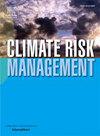Exploring the spatial and temporal changes of compound disasters: A case study in Gaoping River, Taiwan
Abstract
Global climate change has resulted in unusual climatic events of increasing intensity and frequency with severe impacts. An individual disaster is often coupled with another at the same time or in the form of a cascade. Major issues discussed in disaster management range from risks, environmental vulnerability, and resiliency, to the identification of human disaster-inducing land uses and their locations across a region, particularly in watersheds. The accurate identification of these disaster-inducing areas – that is, those locations of land use that may cause or contribute to making downstream impacts worse than they would be in the absence of such land uses – would be of assistance for disaster management agencies in order to mitigate disasters in advance. This study applies spatial autocorrelation statistics to explore the spatial and temporal dynamics associated with compound disasters. The study then utilizes the Soil and Water Assessment Tool (SWAT) to calculate runoff volume and sediment discharge to identify the locations of human disaster-inducing land uses. Our modeling outcomes show that there are various kinds of spatial and temporal clusters among compound disasters, and that certain areas are affected by similar disasters regularly while other locations might be the cause of these regular disasters.

 求助内容:
求助内容: 应助结果提醒方式:
应助结果提醒方式:


